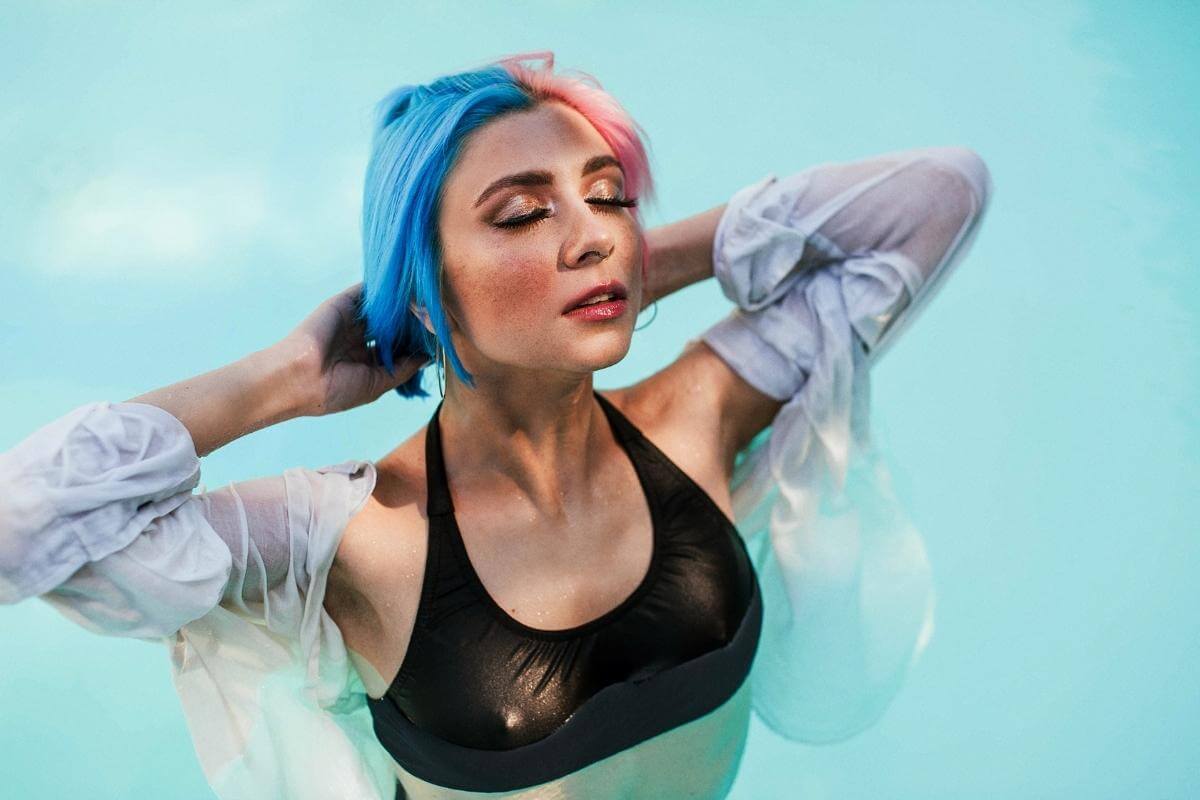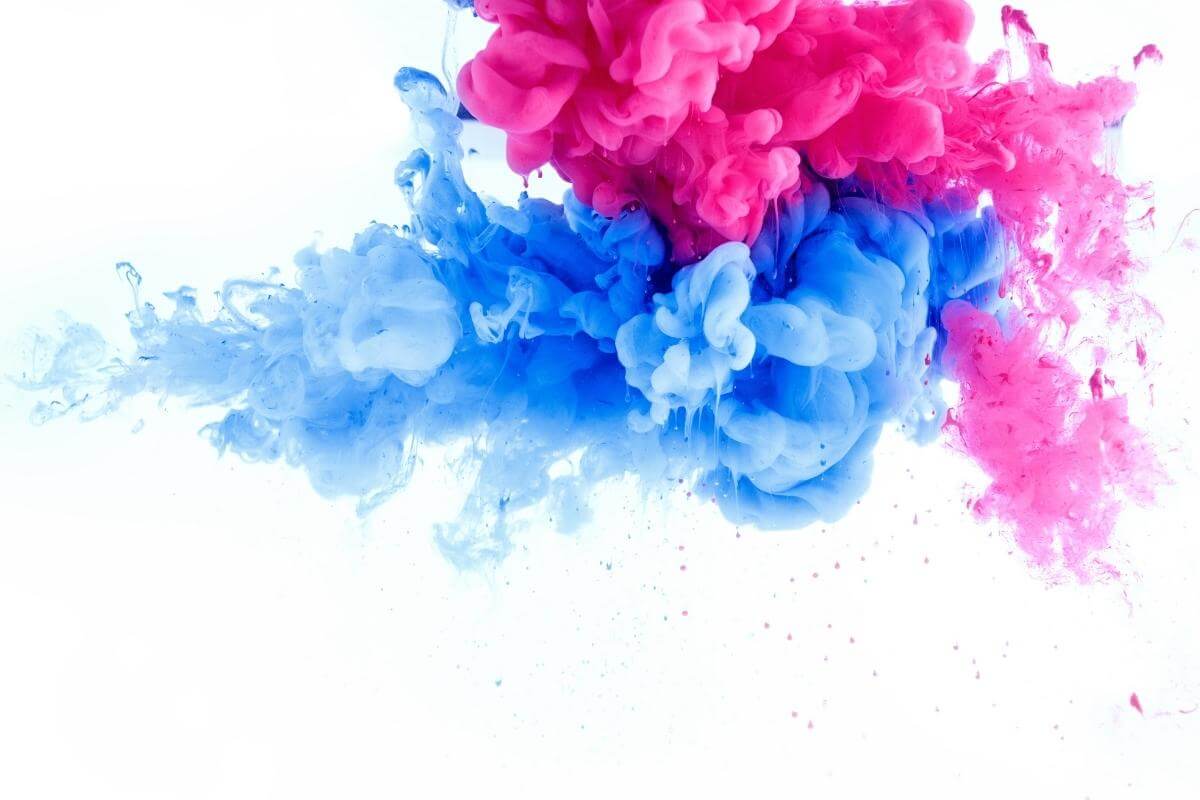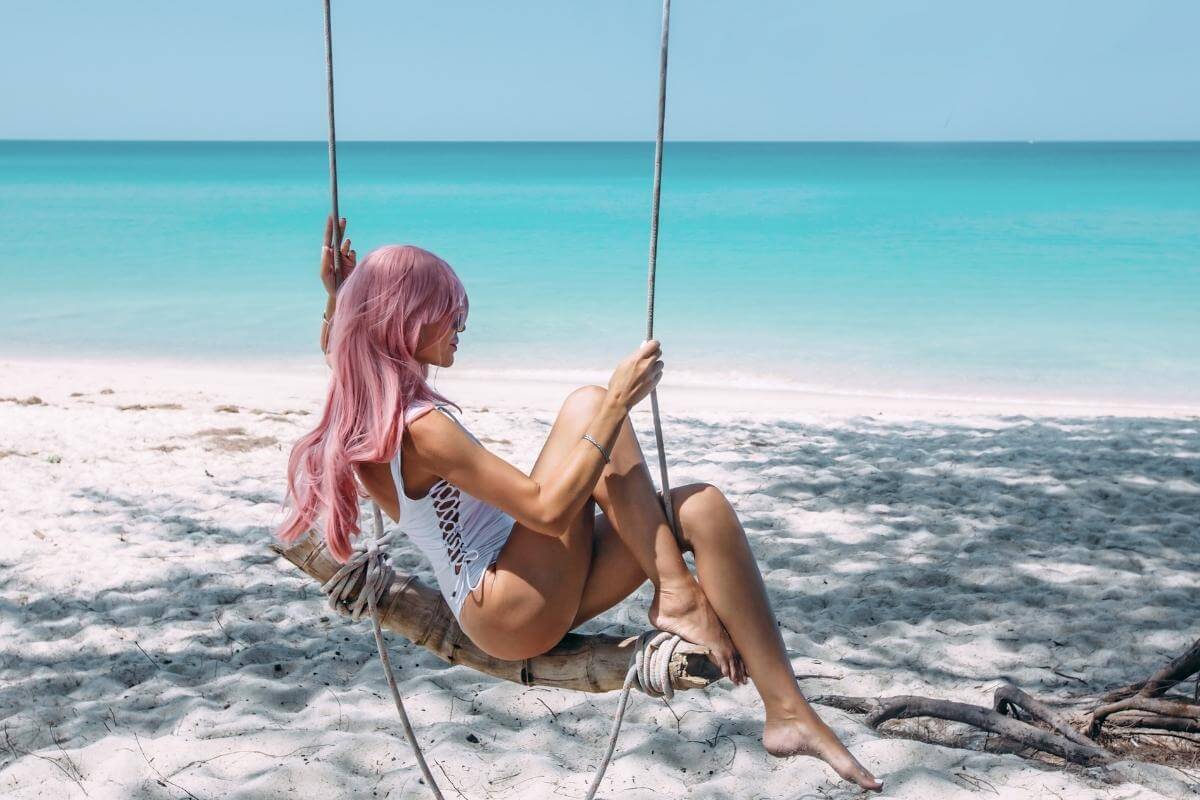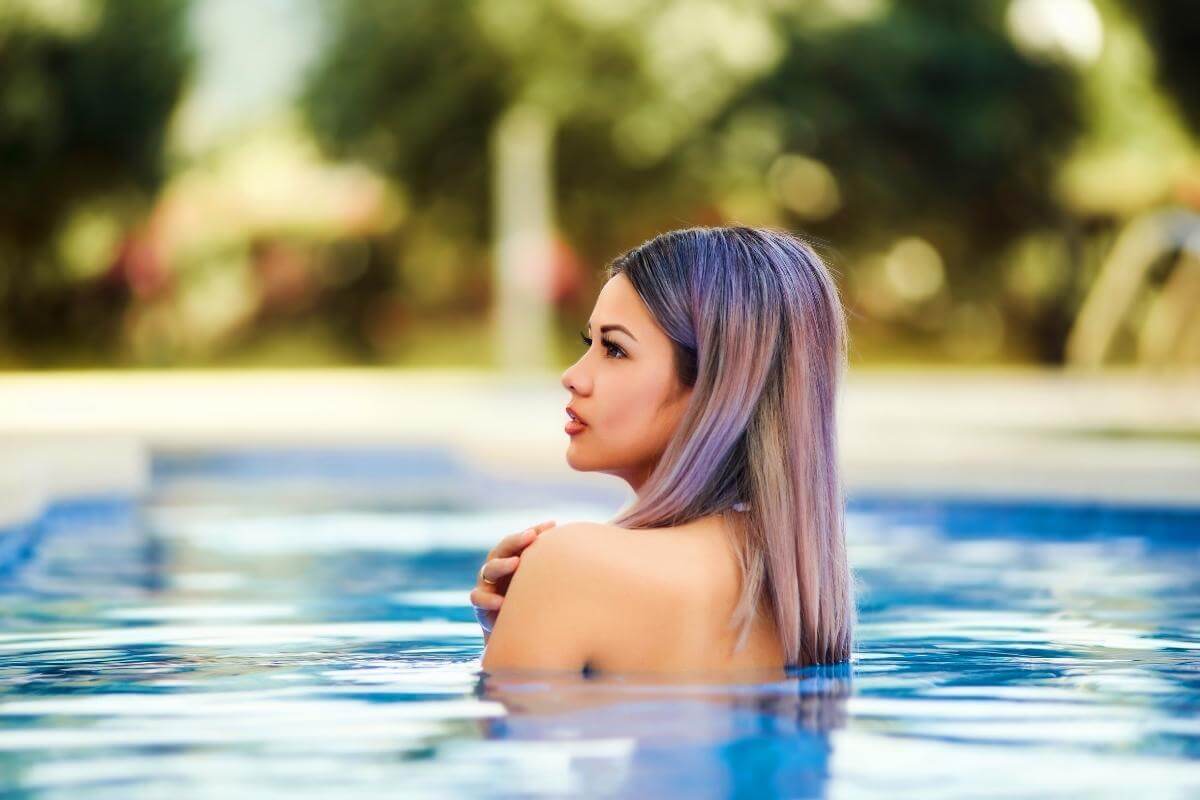Can You Go Swimming After Dyeing Your Hair?
Updated on
This post may contain affiliate links. As an Amazon Associate, we may earn from qualifying purchases.

Me after reading 3 articles that say not to jump into the pool with freshly dyed hair.
Also, me: Dyes my hair pink 2 days before attending a pool party.
Although I had a freaking blast, the pool ended up looking like a whirlwind of pastel hues because I wasn’t the only one with colored hair!
As for my hair…
Splotchy, washed out, I couldn’t tell if it was green or pink in the aftermath!
So this begs the question …
Can You Go Swimming After Dyeing Your Hair?

Table of Contents
Wait 3 – 7 Days to Go Swimming After Dyeing Your Hair
My local hair colorist recommends waiting between 3 – 7 days, depending on the hair dye (semi-permanent or permanent), before jumping into the pool or ocean.
But she also adds that the wait is not as important.
It’s what you do to protect your hair before and after that matters.
Therefore it’s ok to go swimming after dyeing your hair. But I don’t mean to literally jump in the pool on your way back from the hair salon.
Give your hair dye time to settle. You must read the precautionary steps and the aftercare instructions in the box. Most times, the hair dye brands will have information, including when to wash and swim.
Otherwise, not following the instructions properly can lead to unwanted results like faded color, stains on the skin, and potentially harming your health and the health of others around you (for example, hair dye bleeding in a swimming pool).
What Happens If You Swim With Dyed Hair Too Soon?
If you go swimming with newly dyed hair, you risk your hair color washing out and fading much faster. This is especially true with lighter hair colors, which can become dull and discolored from the pool chemicals.

But even if you have dark hair, it’s still not a good idea to swim immediately after dyeing it. That’s because chlorine is highly oxidizing. And sea water contains heavy salts that can exfoliate the color out of your strands.
So here are the potential problems you may encounter:
Rapid Color Fade
Chlorine is a chemical that acts as a bleaching agent. It oxidizes the hair and strips color pigments. As a result, hair color fades rapidly, losing its vibrancy and shine.
Sea water, on the other hand, contains salt, which is abrasive. Salt exfoliates, causing rapid shedding of the color coating on the strands.
Bleeding Hair Dye
Recently-colored hair is at high risk of color bleed. As it stands, your colored locks should have at least 3-7 days of downtime (depending on dye permanence) to avoid any undesirable chemical reactions.
Additionally, when color bleeds, these chemicals can get into your eyes, ears, or nose, and if you’ve read the labels on your bleach and hair dye bottles, it says to avoid contact with these sensitive areas.
Chemical Hazard
When dyed hair leeches into the water, it leaves a chemical trail, which creates a potential chemical hazard for nearby swimmers in the pool.
How Chlorine Affects Hair Dye
Besides color bleed, chlorine can affect hair dye in many other ways too.
Discoloration and Brassiness
Chlorine is the color kryptonite. It oxidizes and soaks into the hair to create a filthy-looking brassy tone. Expect a copper hue in your strands for red hair color and greenish tints on blonde hair.
Read: When chlorine meets copper, blondes go green.
Your hair won’t turn green immediately, but if you’re a competitive swimmer or in the habit of swimming a lot in a chlorinated pool, dyeing your hair and maintaining the color can be quite challenging.
Dryness
Chlorine dehydrates the hair and skin. It eats away at the lipid layer and natural oils that keep them moisturized and balanced. Continuous exposure to chlorine can lead to hair breakage, split ends, and frizziness on top of hair color fade and brassiness.
High Porosity
Continuous exposure to chlorine in swimming pools makes the hair porous, causing it to lose moisture faster, resulting in frizz, breakage, and split ends.
“It affects the hair cuticle making it rough and likely to damage or breakage. These cuticles reflect light poorly, and so the hair fiber looks dull, dry, and may feel rough when touched” Mirian Lima
Colorist and Stylist - StyleCaster
How Sea Water Affects Hair Dye

Now that you know the unsightly effects of chlorinated water, you might think that the smart thing to do is remove chlorine from the equation by not going to your next pool party and going to the beach instead.
Unfortunately, ocean water can also have adverse effects on colored locks.
Salt Dehydrates the Hair
Salt crystals have a corrosive effect. Salt is a drying agent as it absorbs water from its surroundings to retain it in its crystals. When it comes into contact with the skin and hair, it will not only soak up the moisture but also rub and scrub, making the skin and hair feel rough and dehydrated.
Note that hair with yellow pigment is more susceptible to damage than any other pigments, like burgundy, brown, black or blue. However, all will experience rapid moisture loss.
The exfoliating action of salt water also swells and lifts the cuticle cells of the hair strands to make them porous.
Open Hair Cuticles Lead to Color Loss
When the protective barrier of your hair is exposed and the pores of each cuticle are wide open, water has an even better chance of pulling color pigments out. This results in exposing underlying pigments of the hair, like coppery hues, red, or orange, depending on your hair’s true color.
How Long Should You Wait to Swim After Dyeing Your Hair?

Women with permanent hair dye must wait 7 days before diving into the sea or pool water.
For semi-permanent hair dye, wait 3 days (72 hrs) for your dye to settle in to avoid color bleed.
Most hair colorists advocate getting hair dyed 2 weeks before the holiday.
Jo Hansford, color expert and founder of Jo Hansford salon, says if you do root touch-ups every 4 weeks, then getting your hair colored 2 weeks before your holiday gives you ample time to have it redone when you get back. (via Grazia Magazine)
What to Do When You Have Permanent Hair Dye?
As I mentioned, you need to wait a whole week for the pigment to settle and for the dye bleed to stop.
Why? Look at the ingredients of any permanent color dye. It’ll most likely contain ammonia and peroxide, which are strong chemicals that can be extremely dangerous if they dissolve in the pool or seawater. They can also get on your skin, eyes, nose, and ears.
Imagine diving into the water and losing all that product. Most of the permanent color will bleed out and cause blotches to appear.
This will force a desperate visit to the salon to color-correct these spots and have your hair evenly colored, which will be quite costly.
What to Do When You Have a Semi-Permanent Hair Dye?
Semi-permanent dyes are less of a hassle in terms of maintenance. The waiting period is less, i.e, 3-5 days for the dye to settle. And if you experienced color bleed under the sweltering sun, you won’t need to worry much, as these dyes don’t usually contain harsh chemicals like the ones in permanent hair dyes.
Additionally, touch-ups and color corrections for semi-permanent colors are less costly than permanent ones; thus, the abrasiveness of chlorine and salt won’t force you to break the bank.
How to Protect Dyed Hair When Swimming
With that said, here’s how to rock and protect your hair while on vacation!
Wear a Swimming Cap
One of the best ways to protect color-treated hair is with swim caps. While they won’t necessarily keep the water at bay, as they have small cracks and gaps, your beautifully colored locks won’t be completely exposed to the water.
Swim caps provide a physical barrier between the hair and the water, which will protect your tresses to a great extent from chlorine or salt crystals. If your hair is wet even after wearing a swim cap, you can try wearing two over your head.
However, not everyone is a fan of wearing a swim cap, and to be fair, diving into a pool is more fun without a cap. In that case, you might want to try other protective steps.
Check out: The best swim caps that protect hair from chlorine.
Wet Your Hair Before Swimming
Presoak your hair with clean water.
When the hair is saturated with water, it doesn’t have space to absorb anything else. Therefore, it will absorb less chlorine and salt.
It’s that simple!
You don’t have to run all the way to the shower – if you have one handy, a bottle of tap water is absolutely fine.
Apply a Protective Coating to Your Strands
You can use a wide range of hair products to coat your hair before swimming.
A leave-in conditioner, for example, can work as a protective layer giving it more protection from chlorine.
Coconut oil is also good. It forms a solid between the hair and the chlorinated water or ocean water and your hair to minimize color loss.
I’ve also heard about the Aquaguard Pre Swim. I must admit, I haven’t tried it yet. But it looks promising.
Aqua Guard Pre Swim Hair Defense
Also, check out: The best swimmer’s leave-in conditioners.
Wear Sunscreen for Hair
When you go to the pool or the beach, you should treat your hair like you would your skin. Your scalp can get burned if exposed for long durations to the sun. Your hair, on the other hand, will experience breakage.
To avoid this, get a sunscreen spray that protects your locks from ultraviolet rays. Sunscreens with UVA and UVB rays filters are quite effective for colored hair. Also, don’t forget to use scalp sunscreen, as it could easily get burned, particularly if you have thin hair or doing a hairstyle that exposes a large portion of your scalp.
Sun Bum Sunscreen Hair Mist
Keep Your Hair Out of the Water
There’s also the scenario where many unlucky women find themselves: going to the pool or beach without preparation. In this case, there’s only much you can do. These steps are still effective, nevertheless:
- Try to keep your hair dry as much as possible. While it’s very challenging to avoid the water, it’s the best thing you could do in case you don’t have any protective products, caps, hats, or scarves.
- If it’s difficult to keep your strands out of the water (a trying challenge for women with long hair), try updos or topknots. Braids and twists will also limit hair exposure to the water and won’t wet your hair as much.
Shampoo Your Hair
After you’ve dived into the pool, continuing your day seems the most logical thing to do, but hair maintenance doesn’t end with that, unfortunately. You’ll need to wash your hair to remove salt or chlorine residues.
Always rinse your hair with fresh water immediately after coming out of the pool or the sea. A good anti-chlorine shampoo will also help neutralize the chemicals and minerals to prevent your freshly dyed hair from turning green.
Some shampoos cater to specific hair colors, but if you’re not well versed in this area of hair care, a good starting point would be using the Malibu C Swimmers Wellness Shampoo. It’ll effectively remove hard minerals, including chlorine, from your strands.
Malibu C Swimmers Wellness Shampoo Set
Do a Weekly Hair Mask Treatment
A deep conditioner or nourishing hair mask helps your hair replenish with vital nutrients and moisture balance. This can help to compensate for the harsh effects of the sun, sea, and chlorine to keep your hair looking healthy and vibrant.
Final Thoughts
To summarize, chlorine and sea salt can fade hair color fast and cause hair dye to bleed in swimming pools and ocean water.
So next time you go to the pool or sea, be mindful. Take precautions and use the right products to protect your hair color and protect others around you.
About the Author
 Charlene Latreuille
Charlene LatreuilleCharlene Latreuille has been blogging for over 10 years and has a background in digital marketing.
Specializing in women's hair health, she blends scientific insight with practical advice, crafting easy-to-follow guides.


